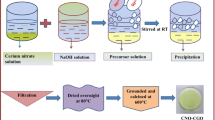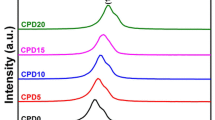Abstract
Gd-doped ceria solid solutions have been recognized to be leading electrolytes for use in intermediate-temperature fuel cells. In this paper, the preparation, solubility, and densification of Gd0.1Ce0.9O1.95 ceramics derived from carbonate co-precipitation are reported. The dissolution of Gd2O3 in CeO2 lattice was identified to be completed during the co-precipitation process by studying the lattice parameter as a function of temperature. After calcination at 800 °C for 2 h, the nano-sized Gd0.1Ce0.9O1.95 powder (∼33 nm) with a nearly spherical shape and a narrow particle-size distribution was obtained. This calcined powder has high sinterability and maximum densification rate at ∼1000 °C. Sintering at 1300 °C for 4 h yielded over 97% relative density with near maximum. The grain size increased with increases in sintering temperature. The ionic conductivity of these pellets was tested by alternating current impedance spectroscopy to elucidate the contribution of intragranular and intergranular conductivity to the total ionic conductivity. It was found that sintering temperature does not affect intragranular conductivity, though intergranular conductivity was strongly influenced by grain size, grain boundary area, and relativity density. This pellet sintered at 1500 °C for 4 h showed a high ionic conductivity of 5.90 × 10−2 s/cm when measured at 750 °C. The characterization and structural evaluation of the as-received powders were carried out using x-ray diffraction, transmission electron microscopy, Brunauer–Emmett–Teller, and dilatometer and impedance analysis.
Similar content being viewed by others
References
J.A. Kilner: Fast anion transport in solids. Solid State Ionics 8, 201 (1983).
R. Gerhard-Anderson and A.S. Nowick: Ionic conductivity of CeO2 with trivalent dopants of different ionic radii. Solid State Ionics 5, 547 (1981).
T. Kudo and H. Obayashi: Oxygen ion conduction of the fluorite-type Ce1−xInxO2−x/2 (Ln = lanthanide element). J. Electrochem. Soc. 122, 142 (1975).
R. Gerhardt, A.S. Nowick, M.E. Mochel and I. Dumler: Grain-boundary effect in ceria doped with trivalent cations: I. Electrical measurement. J. Am. Ceram. Soc. 69, 641 (1986).
R. Gerhardt, A.S. Nowick, M.E. Mochel and I. Dumler: Grain-boundary effect in ceria doped with trivalent cations: II. Microstructure and microanalysis. J. Am. Ceram. Soc. 69, 647 (1986).
B.G. Pound: The characterization of doped CeO2 electrodes in solid oxide fuel cells. Solid State Ionics 52, 183 (1992).
K. Higashi, K. Sonoda, H. Ono, S. Sameshima and Y. Hirata: Synthesis and sintering of rare-earth-doped ceria powder by the oxalate co-precipitation method. J. Mater. Res. 14, 957 (1999).
K. Huang, M. Feng and J.B. Goodenough: Synthesis and electrical properties of dense Ce0.9Gd0.1O1.95 ceramics. J. Am. Ceram. Soc. 81, 357 (1998).
K. Yamashita, K.V. Ramanujachary and M. Greenblatt: Hydrothermal synthesis and low temperature conduction properties of substituted ceria ceramics. Solid State Ionics 81, 53 (1995).
A.I.Y. Tok, L.H. Luo and F.Y.C. Boey: Carbonate co-precipitation of Gd2O3-doped CeO2 solid solution nano-particles. Mater. Sci. Eng. A 383, 229 (2004).
T.S. Zhang, J. Ma, L.B. Kong, P. Hing, S.H. Chan and J.A. Kilner: High-temperature aging behavior of Gd-doped ceria. Electrochem. Solid-State Lett. 7, J13 (2004).
X.J. Chen, K.A. Khor, S.H. Chan and L.G. Yu: Influence of microstructure on the ionic conductivity of yttria-stabilized zirconia electrolyte. Mater. Sci. Eng. A 335, 246 (2002).
M. Mogensen, N.M. Sammes and G.A. Tompsett: Physical, chemical and electrochemical properties of pure and doped ceria. Solid State Ionics 129, 63 (2000).
V.V. Kharton, F.M.D. Marques and A. Atkinson: Transport properties of solid oxide electrolyte ceramics: A brief review. Solid State Ionics. 174, 135 (2004).
Author information
Authors and Affiliations
Corresponding author
Additional information
Address all correspondence to this author.
Rights and permissions
About this article
Cite this article
Tok, A.I.Y., Luo, L.H. & Boey, F.Y.C. Consolidation and properties of Gd0.1Ce0.9O1.95 nanoparticles for solid-oxide fuel cell electrolytes. Journal of Materials Research 21, 119–124 (2006). https://doi.org/10.1557/jmr.2006.0024
Received:
Accepted:
Published:
Issue Date:
DOI: https://doi.org/10.1557/jmr.2006.0024




